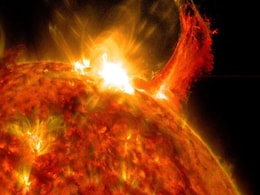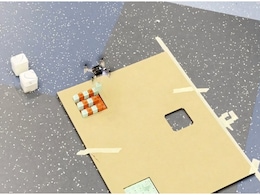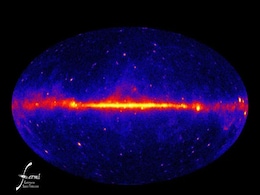Science Models
- All
- News
- Videos
-

Scientists Create Earth's Most Accurate Digital Twin To Date, Could Revolutionise Climate Modelling
- Wednesday November 12, 2025
- Science | Edited by Ritu Singh
The model operates at a 1.25-kilometer resolution, a massive improvement over traditional models that typically have a 40-kilometer resolution.
-
 www.ndtv.com
www.ndtv.com
-

Webb Finds Phosphorus-Bearing Gas in an Ancient Brown Dwarf
- Monday November 10, 2025
- Written by Gadgets 360 Staff
NASA’s James Webb Space Telescope has detected phosphine (PH₃) in the atmosphere of the ancient brown dwarf Wolf 1130C, about 54 light-years away in Cygnus. This marks the first confirmed detection of a phosphorus-bearing gas in such a metal-poor object. The finding surprises astronomers, as phosphine was previously undetected in similar brown ...
-
 www.gadgets360.com
www.gadgets360.com
-

Scientists Just Solved the Mystery of the Moon’s Lopsided Dust Halo
- Sunday November 9, 2025
- Written by Gadgets 360 Staff
Scientists have solved why the Moon’s dust cloud is uneven: heat. Using computer models, researchers found that meteor impacts on the Moon’s sunlit surface fling 6–8% more dust into space than on the cold night side, creating a lopsided halo. NASA warns this dust could threaten future landers and astronauts.
-
 www.gadgets360.com
www.gadgets360.com
-

Dark Matter and Dark Energy Might Not Exist After All, New Study Suggests
- Saturday November 8, 2025
- Written by Gadgets 360 Staff
A new theory suggests dark matter and dark energy may not exist. Physicist Rajendra Gupta’s model proposes that the universe’s forces weaken over time, naturally explaining cosmic expansion and galactic motion without unseen matter or energy.
-
 www.gadgets360.com
www.gadgets360.com
-

Astronomers Spot Signs of Baby Planets in a Star’s Mysterious Disk
- Friday November 7, 2025
- Written by Gadgets 360 Staff
Astronomers using Keck Observatory have imaged the dusty disk around HD 34282, a young star about 400 light-years away, revealing bright clumps and a 40 AU gap—clear signs of planet formation. The system provides a rare glimpse into early planetary birth, helping refine models of how gas and dust evolve into new worlds.
-
 www.gadgets360.com
www.gadgets360.com
-

NASA's James Webb Space Telescope Telescope Challenges Old Theories on Mini-Neptune Worlds
- Friday November 7, 2025
- Written by Gadgets 360 Staff
New models suggest mini-Neptunes—planets smaller than Neptune with thick gas envelopes—may have solid rocky surfaces instead of molten magma. Data from NASA’s JWST revealed high-pressure atmospheres capable of compressing molten rock into solid crusts. This discovery challenges earlier assumptions and offers key insights into exoplanet compos...
-
 www.gadgets360.com
www.gadgets360.com
-

Hubble Observes Massive Stellar Eruption from EK Draconis, Hinting at Life’s Origins
- Sunday November 2, 2025
- Written by Gadgets 360 Staff
Astronomers using the Hubble Space Telescope observed a huge solar storm from EK Draconis, a young Sun-like star. The eruption’s energy may trigger atmospheric chemistry, forming greenhouse gases and organic molecules. Such events could mirror early solar activity that helped spark life on ancient Earth and distant exoplanets.
-
 www.gadgets360.com
www.gadgets360.com
-

Scientists May Have Finally Solved the Sun’s Mysteriously Hot Atmosphere Puzzle
- Thursday October 30, 2025
- Written by Gadgets 360 Staff
Scientists using the Daniel K. Inouye Solar Telescope have detected Alfvén waves in the Sun’s corona, potentially solving the long-standing mystery of its extreme heat and helping refine models of solar and stellar energy transfer.
-
 www.gadgets360.com
www.gadgets360.com
-

Researchers Use AI to Predict Storm Surges Faster and More Accurately
- Monday October 27, 2025
- Written by Gadgets 360 Staff
AI-powered models are transforming storm surge forecasting by generating accurate coastal flood predictions in minutes. Using past storm data and neural networks, these systems outperform traditional physics models, helping coastal communities prepare faster as climate change drives stronger hurricanes and higher seas.
-
 www.gadgets360.com
www.gadgets360.com
-

Carnegie Mellon’s AI Drones Can Build Mid-Air Structures With 90 Percent Success Rate
- Sunday October 26, 2025
- Written by Gadgets 360 Staff
Carnegie Mellon engineers have unveiled AI-controlled drones that 3D print by snapping magnetic blocks together mid-air. Powered by a large language model, the drones translate simple commands into precise construction plans, achieving 90% accuracy. The technology could enable aerial infrastructure repair and emergency shelter construction in hard-...
-
 www.gadgets360.com
www.gadgets360.com
-

Flattened Dark Matter May Explain Mysterious Gamma-Ray Glow at Milky Way’s Core, Study Finds
- Sunday October 26, 2025
- Written by Gadgets 360 Staff
Dark matter near the Milky Way’s center appears flattened, not spherical, according to new simulations. The discovery may explain a puzzling gamma-ray glow long observed by NASA’s Fermi telescope, reigniting theories that dark matter collisions produce high-energy radiation in the galaxy’s core
-
 www.gadgets360.com
www.gadgets360.com
-

NASA Telescopes Capture First-Ever Companion Star Orbiting Massive Red Supergiant Betelgeuse
- Sunday October 26, 2025
- Written by Gadgets 360 Staff
Astronomers have detected a small companion star orbiting the red supergiant Betelgeuse using Hubble and Chandra observations. Dubbed “Betelbuddy,” the discovery reveals an extreme binary system that challenges existing models of stellar evolution and may offer clues to Betelgeuse’s future.
-
 www.gadgets360.com
www.gadgets360.com
-

Scientists Caution That Artificial Cooling of Earth May Disrupt Monsoons and Weather Systems
- Sunday October 26, 2025
- Written by Gadgets 360 Staff
A new Scientific Reports study warns that dimming the Sun with sulfur aerosols could cause severe side effects, including disrupted monsoons, ozone loss, and acid rain. Researchers stress that despite its cooling potential, such geoengineering carries unpredictable global risks that outweigh short-term benefits.
-
 www.gadgets360.com
www.gadgets360.com
-

NDTV World Summit 2025: MIT Researcher Explains Why AI Models Give Errors, And Its Future
- Saturday October 18, 2025
- World News | Edited by Chandrajit Mitra
The advent of Artificial Intelligence (AI) has brought chaos in our daily applications, but that's changing rapidly, said Neil Thompson, director of the FutureTech Research Project at MIT's Computer Science and Artificial Intelligence Lab.
-
 www.ndtv.com
www.ndtv.com
-

Scientists Create Earth's Most Accurate Digital Twin To Date, Could Revolutionise Climate Modelling
- Wednesday November 12, 2025
- Science | Edited by Ritu Singh
The model operates at a 1.25-kilometer resolution, a massive improvement over traditional models that typically have a 40-kilometer resolution.
-
 www.ndtv.com
www.ndtv.com
-

Webb Finds Phosphorus-Bearing Gas in an Ancient Brown Dwarf
- Monday November 10, 2025
- Written by Gadgets 360 Staff
NASA’s James Webb Space Telescope has detected phosphine (PH₃) in the atmosphere of the ancient brown dwarf Wolf 1130C, about 54 light-years away in Cygnus. This marks the first confirmed detection of a phosphorus-bearing gas in such a metal-poor object. The finding surprises astronomers, as phosphine was previously undetected in similar brown ...
-
 www.gadgets360.com
www.gadgets360.com
-

Scientists Just Solved the Mystery of the Moon’s Lopsided Dust Halo
- Sunday November 9, 2025
- Written by Gadgets 360 Staff
Scientists have solved why the Moon’s dust cloud is uneven: heat. Using computer models, researchers found that meteor impacts on the Moon’s sunlit surface fling 6–8% more dust into space than on the cold night side, creating a lopsided halo. NASA warns this dust could threaten future landers and astronauts.
-
 www.gadgets360.com
www.gadgets360.com
-

Dark Matter and Dark Energy Might Not Exist After All, New Study Suggests
- Saturday November 8, 2025
- Written by Gadgets 360 Staff
A new theory suggests dark matter and dark energy may not exist. Physicist Rajendra Gupta’s model proposes that the universe’s forces weaken over time, naturally explaining cosmic expansion and galactic motion without unseen matter or energy.
-
 www.gadgets360.com
www.gadgets360.com
-

Astronomers Spot Signs of Baby Planets in a Star’s Mysterious Disk
- Friday November 7, 2025
- Written by Gadgets 360 Staff
Astronomers using Keck Observatory have imaged the dusty disk around HD 34282, a young star about 400 light-years away, revealing bright clumps and a 40 AU gap—clear signs of planet formation. The system provides a rare glimpse into early planetary birth, helping refine models of how gas and dust evolve into new worlds.
-
 www.gadgets360.com
www.gadgets360.com
-

NASA's James Webb Space Telescope Telescope Challenges Old Theories on Mini-Neptune Worlds
- Friday November 7, 2025
- Written by Gadgets 360 Staff
New models suggest mini-Neptunes—planets smaller than Neptune with thick gas envelopes—may have solid rocky surfaces instead of molten magma. Data from NASA’s JWST revealed high-pressure atmospheres capable of compressing molten rock into solid crusts. This discovery challenges earlier assumptions and offers key insights into exoplanet compos...
-
 www.gadgets360.com
www.gadgets360.com
-

Hubble Observes Massive Stellar Eruption from EK Draconis, Hinting at Life’s Origins
- Sunday November 2, 2025
- Written by Gadgets 360 Staff
Astronomers using the Hubble Space Telescope observed a huge solar storm from EK Draconis, a young Sun-like star. The eruption’s energy may trigger atmospheric chemistry, forming greenhouse gases and organic molecules. Such events could mirror early solar activity that helped spark life on ancient Earth and distant exoplanets.
-
 www.gadgets360.com
www.gadgets360.com
-

Scientists May Have Finally Solved the Sun’s Mysteriously Hot Atmosphere Puzzle
- Thursday October 30, 2025
- Written by Gadgets 360 Staff
Scientists using the Daniel K. Inouye Solar Telescope have detected Alfvén waves in the Sun’s corona, potentially solving the long-standing mystery of its extreme heat and helping refine models of solar and stellar energy transfer.
-
 www.gadgets360.com
www.gadgets360.com
-

Researchers Use AI to Predict Storm Surges Faster and More Accurately
- Monday October 27, 2025
- Written by Gadgets 360 Staff
AI-powered models are transforming storm surge forecasting by generating accurate coastal flood predictions in minutes. Using past storm data and neural networks, these systems outperform traditional physics models, helping coastal communities prepare faster as climate change drives stronger hurricanes and higher seas.
-
 www.gadgets360.com
www.gadgets360.com
-

Carnegie Mellon’s AI Drones Can Build Mid-Air Structures With 90 Percent Success Rate
- Sunday October 26, 2025
- Written by Gadgets 360 Staff
Carnegie Mellon engineers have unveiled AI-controlled drones that 3D print by snapping magnetic blocks together mid-air. Powered by a large language model, the drones translate simple commands into precise construction plans, achieving 90% accuracy. The technology could enable aerial infrastructure repair and emergency shelter construction in hard-...
-
 www.gadgets360.com
www.gadgets360.com
-

Flattened Dark Matter May Explain Mysterious Gamma-Ray Glow at Milky Way’s Core, Study Finds
- Sunday October 26, 2025
- Written by Gadgets 360 Staff
Dark matter near the Milky Way’s center appears flattened, not spherical, according to new simulations. The discovery may explain a puzzling gamma-ray glow long observed by NASA’s Fermi telescope, reigniting theories that dark matter collisions produce high-energy radiation in the galaxy’s core
-
 www.gadgets360.com
www.gadgets360.com
-

NASA Telescopes Capture First-Ever Companion Star Orbiting Massive Red Supergiant Betelgeuse
- Sunday October 26, 2025
- Written by Gadgets 360 Staff
Astronomers have detected a small companion star orbiting the red supergiant Betelgeuse using Hubble and Chandra observations. Dubbed “Betelbuddy,” the discovery reveals an extreme binary system that challenges existing models of stellar evolution and may offer clues to Betelgeuse’s future.
-
 www.gadgets360.com
www.gadgets360.com
-

Scientists Caution That Artificial Cooling of Earth May Disrupt Monsoons and Weather Systems
- Sunday October 26, 2025
- Written by Gadgets 360 Staff
A new Scientific Reports study warns that dimming the Sun with sulfur aerosols could cause severe side effects, including disrupted monsoons, ozone loss, and acid rain. Researchers stress that despite its cooling potential, such geoengineering carries unpredictable global risks that outweigh short-term benefits.
-
 www.gadgets360.com
www.gadgets360.com
-

NDTV World Summit 2025: MIT Researcher Explains Why AI Models Give Errors, And Its Future
- Saturday October 18, 2025
- World News | Edited by Chandrajit Mitra
The advent of Artificial Intelligence (AI) has brought chaos in our daily applications, but that's changing rapidly, said Neil Thompson, director of the FutureTech Research Project at MIT's Computer Science and Artificial Intelligence Lab.
-
 www.ndtv.com
www.ndtv.com



















